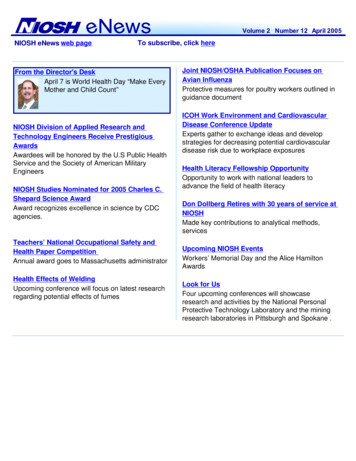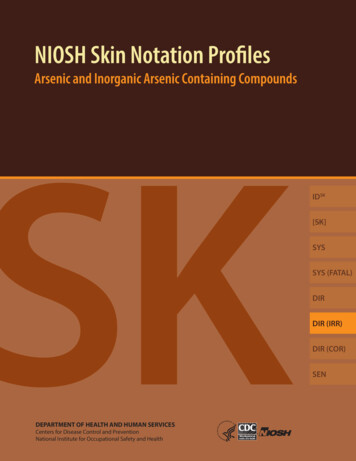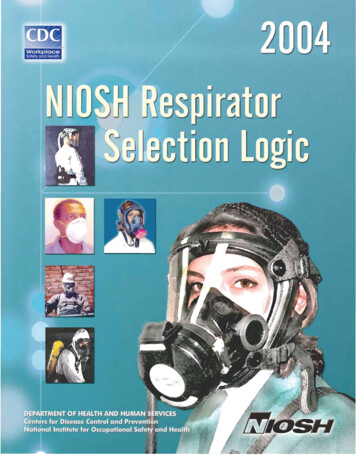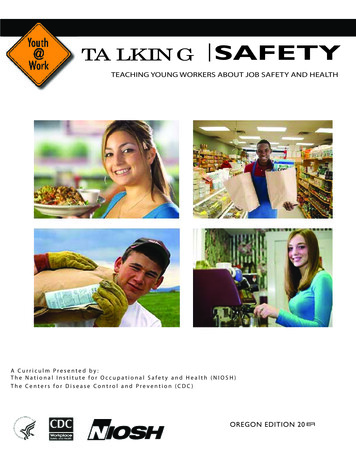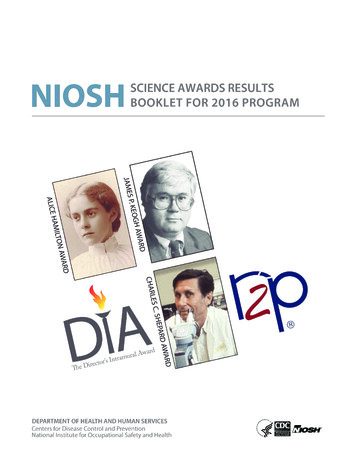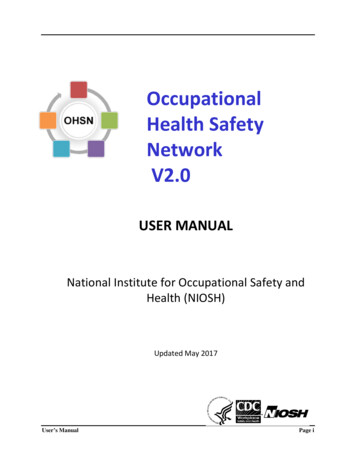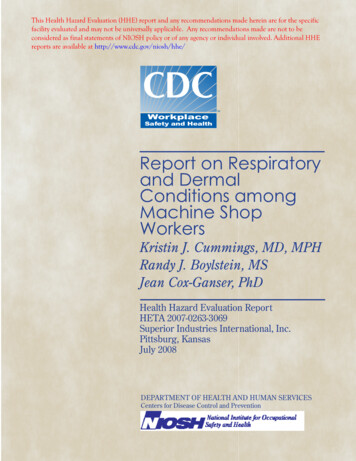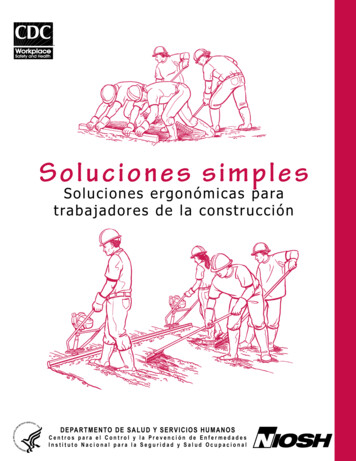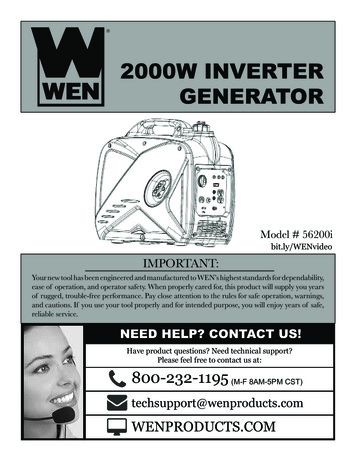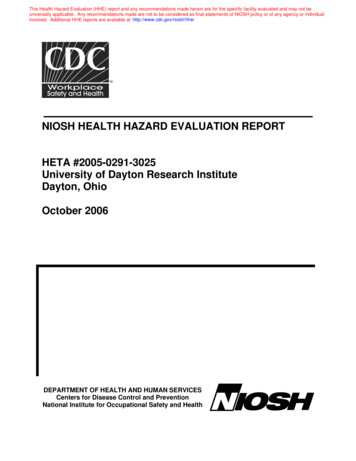
Transcription
This Health Hazard Evaluation (HHE) report and any recommendations made herein are for the specific facility evaluated and may not beuniversally applicable. Any recommendations made are not to be considered as final statements of NIOSH policy or of any agency or individualinvolved. Additional HHE reports are available at http://www.cdc.gov/niosh/hhe/NIOSH HEALTH HAZARD EVALUATION REPORTHETA #2005-0291-3025University of Dayton Research InstituteDayton, OhioOctober 2006DEPARTMENT OF HEALTH AND HUMAN SERVICESCenters for Disease Control and PreventionNational Institute for Occupational Safety and Health
PREFACEThe Hazard Evaluation and Technical Assistance Branch (HETAB) of the National Institute forOccupational Safety and Health (NIOSH) conducts field investigations of possible health hazards in theworkplace. These investigations are conducted under the authority of Section 20(a)(6) of the OccupationalSafety and Health (OSHA) Act of 1970, 29 U.S.C. 669(a)(6) which authorizes the Secretary of Health andHuman Services, following a written request from any employers or authorized representative ofemployees, to determine whether any substance normally found in the place of employment haspotentially toxic effects in such concentrations as used or found.HETAB also provides, upon request, technical and consultative assistance to federal, state, and localagencies; labor; industry; and other groups or individuals to control occupational health hazards and toprevent related trauma and disease. Mention of company names or products does not constituteendorsement by NIOSH.ACKNOWLEDGMENTS AND AVAILABILITY OF REPORTThis report was prepared by Mark M. Methner, Ph.D., CIH of HETAB, Division of Surveillance, HazardEvaluations and Field Studies (DSHEFS). Total carbon samples and analyses were performed by M.Eileen Birch, Ph.D., Division of Applied Research and Technology (DART). Real-time aerosolmeasurements were performed by Douglas Evans, Ph.D. (DART) and Robert McCleery, M.S., CIH(DSHEFS). Electrostatic precipitator samples were collected by Mark D. Hoover, Ph.D., CHP, CIH,Division of Respiratory Diseases (DRDS). Ventilation assessment was performed by Keith Crouch, Ph.D.(DART). All transmission electron microscopy (TEM) was performed by Bon-Ki Ku, Ph.D. (DART).Desktop publishing was performed by Robin Smith. Editorial assistance was provided by Ellen Galloway.Copies of this report have been sent to management representatives at University of Dayton ResearchInstitute (UDRI) and the OSHA Regional Office. This report is not copyrighted and may be freelyreproduced. The report may be viewed and printed from the following internet address:http://www.cdc.gov/niosh/hhe. Copies may be purchased from the National Technical InformationService (NTIS) at 5825 Port Royal Road, Springfield, Virginia 22161.For the purpose of informing affected employees, copies of this reportshall be posted by the employer in a prominent place accessible to theemployees for a period of 30 calendar days.ii
Highlights of Health Hazard EvaluationHighlights of the NIOSH Health Hazard EvaluationOn July 8, 2005, the National Institute for Occupational Safety and Health (NIOSH) received amanagement request to conduct a health hazard evaluation (HHE) at the University of Dayton ResearchInstitute (UDRI) in Dayton, Ohio. The request asked NIOSH to evaluate potential sources of emissionsfrom carbon nanofiber handling processes. No health complaints were reported by management orworkers.What University of Dayton ResearchInstitute (UDRI) Managers Can DoWhat NIOSH Did We observed work practices.We took air and surface samples for carbonnanofibers.We measured carbon nanofibers in the airusing real-time instruments.We evaluated the laboratory ventilationsystem.We looked at the type of personal protectiveequipment (PPE) used by workers. What NIOSH Found Most handling processes did not releasecarbonnanofibers.However,someprocesses (wet sawing of composite materialand transferring carbon nanofibers to amixing vessel) did raise the airborne particleconcentrationwhencomparedtobackground levels.Carbon nanofiber materials are tracked outof the laboratory and into office areas(probably on the soles of footwear). Use local exhaust ventilation whentransferring carbon nanofibers to mixingvessel and when using the wet saw.Train laboratory workers on proper carbonnanofiber handling techniques.Evaluate the ventilation system to ensure itis operating according to manufacturer’sspecifications.Install “sticky mats” at all doors leadingto/from the laboratory. Change mats whenthey no longer feel sticky.Make sure a vacuum equipped with a highefficiency particulate air (HEPA) filter isused to clean up any spilled carbonnanofibers.Use gloves made of nitrile rubber instead oflatex.What the University of Dayton ResearchInstitute (UDRI) Employees Can Do Wear PPE provided by management whenhandling carbon nanofibers.Make sure footwear is placed on “stickymats” before entering/exiting the laboratory.What To Do For More Information:We encourage you to read the full report. If youwould like a copy, either ask your health andsafety representative to make you a copy or call1-513-841-4252 and ask forHETA Report #2005-0291-3025iii
Health Hazard Evaluation Report 2005-0291-3025University of Dayton Research InstituteDayton, OhioOctober 2006Mark M. Methner, Ph.D., CIHM. Eileen Birch, Ph.D.Douglas Evans, Ph.D.Mark D. Hoover, Ph.D., CHP, CIHSUMMARYOn July 8, 2005, the National Institute for Occupational Safety and Health (NIOSH) received amanagement request to conduct a health hazard evaluation (HHE) at the University of Dayton ResearchInstitute (UDRI) in Dayton, Ohio. The request asked NIOSH to evaluate potential sources of emissionsfrom carbon nanofiber handling processes. No health complaints were reported by management orworkers.Measurements made with real-time instruments capable of sizing and determining airborne particleconcentrations indicate that most processes did not release substantial quantities of carbon nanofiberswhen compared to background particle measurements. However, some processes (wet sawing ofcomposite material and the transferring of carbon nanofibers to a mixing vessel) did elevate area airborneparticle mass concentrations. Surface sampling indicated that carbon nanofiber material migrated from thelaboratory to an adjacent office area, with employee footwear being the most likely means of transport.Despite the absence of occupational exposure criteria, UDRI management decided to take a cautiousapproach and instituted a policy requiring the use of personal protective equipment (PPE). The PPE usedby lab workers included disposable Tyvek lab coats, latex gloves, and elastomeric half-mask respiratorswith a P100 pre-filter and organic vapor cartridge. A laboratory hood and local exhaust ventilation wereevaluated with “smoke tubes” and appeared to operate as designed.NIOSH investigators cannot conclude whether a health hazard exists to UDRI laboratoryworkers from exposure to nano-scale materials. There are currently no occupationalexposure limits for carbon nanofibers nor clearly defined health effects, so noconclusions can be made regarding excessive exposure. The UDRI lab did have exhaustventilation available to control potential releases of carbon nanofibers, but the ventilationwas not operating during mixing outside the laboratory hood or wet saw cutting. The labworkers were wearing PPE; however, latex gloves should be replaced with nitrile glovesto avoid the potential development of latex allergy.Keywords: NAICS 541710 (Research and Development in the Physical, Engineering, and Life Sciences),nanotechnology, nanoparticles, carbon nanofibers, composites, polymers, exposure assessment, particleconcentration, nanomaterial handling practices, fugitive emissions.iv
Table of ContentsPreface.iiAcknowledgments and Availability of Report.iiHighlights of Health Hazard Evaluation .iiiSummary.ivIntroduction. 1Background . 1Methods. 2Measuring Carbon Nanofiber Emissions. 2Direct Reading Instrumentation. 3Total Carbon . 3Inhalable Dust . 4Filter/Transmission Electron Microscopy Grid Samples . 4Ventilation Assessment . 4Evaluation Criteria . 4Results . 6Direct Reading Instrumentation. 6Condensation Particle Counter. 6Diffusion Charger . 6Aerosol Photometer (DustTrak ) . 6Electrical Low Pressure Impactor. 6Total Carbon . 6Filter/Transmission Electron Microscopy Grid Samples . 7Ventilation Assessment . 7Personal Protective Equipment . 8Discussion . 8Conclusions. 8Recommendations . 9References. 10
INTRODUCTIONOn July 8, 2005, the National Institute forOccupational Safety and Health (NIOSH)received a request from the manager of apolymer nanocomposite research laboratory atthe University of Dayton Research Institute(UDRI) to conduct a health hazard evaluation(HHE) at their facility in Dayton, Ohio.Specifically, NIOSH was asked to evaluateemployee exposures to nanomaterials (carbonnanofibers) during various handling operationsin the Kettering Laboratory Annex.The Center for Basic and Applied PolymerResearch at UDRI is staffed by professionalswith expertise in polymer engineering andscience. The UDRI laboratories conductresearch, development, and technical serviceprojects on polymeric materials. Activities at theCenter include research on plastics, aterials.On September 1, 2005, NIOSH investigatorsmet with UDRI researchers and managementstaff to address their concerns and to observeengineered nanomaterial handling operations.On December 8, 2005, NIOSH investigatorsconducted air and surface sampling fornanomaterials during various material handlingoperations in the laboratory.BACKGROUNDThe scientific literature has limited informationon adverse health effects related to exposure toengineered nanomaterials. Additionally, thereare no occupational exposure limits erials present new challenges tounderstanding, predicting, and managingpotential health risks to workers.1 In the case ofnanomaterials, the uncertainties are greatbecause the characteristics of nanomaterials maybe different from those of larger particles withthe same chemical composition.Health Hazard Evaluation Report No. 2005-0291-3025A nanometer (nm) is one billionth of a meter(10-9 meters) — about one ten-thousandth thediameter of a human hair, a thousand timessmaller than a red blood cell, or about half thesize of the diameter of deoxyribonucleic acid(DNA). For the purpose of this report,nanotechnology is defined as follows: researchand technology development at the atomic,molecular, or macromolecular levels using alength scale of approximately 1 to 100nanometers in any one dimension; the creationand use of structures, devices and systems thathave novel properties and functions because oftheir small size; and the ability to control ormanipulate matter on an atomic scale. Thedefinition of nanotechnology does not includeincidentally produced nanomaterials, nano-sizedparticles or materials that occur naturally in theenvironment, such as viruses or volcanic ash,nor nanoparticle byproducts of human activity,such as diesel exhaust particulates or othercombustion aerosols.Some manufacturing processes such as spraydrying and calcining may produce nano-sizedparticles that may or may not have propertiesdifferent from those of the bulk material fromwhich they were developed. While there areoften several sources of emissions in anymanufacturing process, packaging and transferoperations involving nano-scale materials mayprovide the greatest potential for release andresultant occupational exposure.2 The risk ofparticle release during production appears to below because most production processes takeplace in closed systems with appropriatefiltering systems. Contamination and exposureto workers is more likely to happen duringhandling and bagging of the material and duringcleaning operations.During the formulation of nanomaterials intoproducts (e.g., coatings and compositematerials), releases and exposures may occurduring transfer/unloading operations; however,once the nanomaterial is incorporated into theformulation, the nanoparticles are typicallyimmobilized in the matrix. For some products,release and exposure to nano-scale materialsafter incorporation into the finished product arePage 1
expected to be low.2 However, there still remainsa potential for nanomaterial release upondestructive processing of the nanomaterialmatrix, for example by cutting, drilling,grinding, and machining.Exposure RoutesThe most common route of exposure to airborneparticles in the workplace is inhalation. Thedeposition of discrete nanoparticles in therespiratory tract is determined by the particle’saerodynamic or thermodynamic diameter(depending on particle size). Agglomerates ofnanoparticles will likely deposit according to thediameter of the agglomerate and not theconstituent nanoparticles.3Discrete nanoparticles are deposited in the lungsto a greater extent than larger respirableparticles, and deposition increases with exercise(due to increase in breathing rate and changefrom nasal to mouth breathing3,4) and amongpersons with existing lung diseases orconditions.5 Based on the findings from animalstudies, discrete nanoparticles may enter thebloodstream from the lungs and translocate toother organs.6,7Ingestion is another route whereby nanoparticlesmay enter the body. Ingestion can occur fromunintentional hand to mouth transfer of materialsin the workplace. This can occur with traditionalmaterials, and it is reasonable to assume that italso could occur during handling ofnanomaterials. Ingestion may also accompanyinhalation exposure because particles clearedfrom the respiratory tract via the mucociliaryescalator may be swallowed.4 Little is knownabout possible adverse effects from the ingestionof nanoparticles.Some studies suggest that nanoparticles alsocould enter the body through the skin duringoccupational exposure. The United KingdomRoyal Society and Royal Academy of Engineershave reported that unpublished studies indicatenanoparticles of titanium dioxide used insunscreens do not penetrate beyond theepidermis.8 However, another study indicatedPage 2that particles smaller than 1000 nm in diametermay penetrate into mechanically flexed skinsamples.9 A more recent study reported thatnanoparticles with varying physicochemicalproperties were able to penetrate the intact skinof pigs.10 These nanoparticles were quantumdots of different size, shape, and surfacecoatings and were reported to penetrate thestratum corneum barrier by passive diffusionand to localize within the epidermal and dermallayers within 8 to 24 hours. The dosing solutionswere two- to fourfold dilutions of quantum dotsas commercially supplied and representoccupationally relevant doses. This studysuggests that the skin is a potential route ofexposure for nanoparticles in the workplace.METHODSMeasuring CarbonNanofiber EmissionsA potential issue when quantifying exposure isthat mass dose may not be an appropriate metricto characterize exposure to nanomaterials. Whenconsidering mass as an exposure dose metric, acritical question is whether it is most appropriateto measure the mass of individual particles(which are less than 100 nm in one dimension)or agglomerates. The dynamics of nanomaterialagglomeration can play a critical role indetermining the pulmonary deposition ofrespirable nanoscale material, where largeraggregates of particles tend to deposit in theupper airways, while dispersed nanomaterialsoften reach the alveoli region.Studies have indicated that toxicity increaseswith decreasing particle size and that particlesurface area may be a better metric formeasuring exposures. This is of particularconcern for nanomaterials, which typically havevery high surface-area-to-mass ratios. Anymaterial’s biochemical reactivity is highlydependent upon its surface chemistry.Bioreactivity may be more pronounced innanoscale particles where, for a given number ormass of particles, the total surface area deliveredis dramatically larger than for the equivalentHealth Hazard Evaluation Report No. 2005-0291-3025
number or mass of microscale particles. Studiesin rodents have shown that the toxicity of somenanoscale particles correlates with increasedparticle surface area,11 whereas other particlesdemonstrate no increase in toxicity withdecreased size.12 There are no wearableinstruments that can monitor the surface area ofparticles in a worker’s breathing zone. Whilethere could be a correlation between mass andsurface area (i.e., mass of each particlemultiplied by the specific surface area of eachparticle), there are typically large variationsbetween particle mass and surface area.13The importance of particle number concentrationas an exposure dose metric is currently unclearfrom the toxicology literature. In many cases,biological response may relate more to totalparticle surface area than to number of particles.However, in some cases the number of particlesdepositing in the respiratory system orpenetrating beyond the respiratory system maybe important.The main goal of this NIOSH evaluation was toexamine various processes and tasks involved inthe handling of carbon nanofiber materials anddetermine whether the magnitude of emissionscould lead to occupational exposure. The initialstep in this emissions characterization surveywas to identify sources on a process-by-processbasis during a walk-through survey of thelaboratory. Based on observations made duringthe walk-through, the following specificprocesses were identified for evaluation:1. Chopping of extruded composite materialcontaining carbon nanofibers.2. Transferring approximately one pound ofcarbon nanofibers from a plasticreceptacle outside a laboratory hood to asmall beaker for weighing inside thehood.3. Transferring and mechanically mixingcarbon nanofibers with acetone inside a5-gallon mixing vessel positioned on thefloor outside the hood with no operatinglocal exhaust ventilation.4. Cutting composite material using a watercooled table saw.Health Hazard Evaluation Report No. 2005-0291-30255. Sifting oven-dried, epoxy-coated carbonnanofibers on an open bench-top toremove impurities.On a subsequent visit, various instrumentsassembled on mobile sampling carts were usedto collect time-synchronized particle data (i.e.,number of particles, size distribution, particlesurface area, particle mass concentration) duringeach process. Air and surface samples forlaboratory analyses also were collected.Equipment and methods used are described inthe following sections.Direct Reading InstrumentationThe following real-time instruments were usedto measure particle number concentration,particle active surface area, particle massconcentration, and particle size distribution bynumber during various tasks: Condensation Particle Counter (CPC,Model 3007; TSI Inc. Shoreview,Minnesota): Measures total number ofparticles/cubic centimeter (cc) of air (10nm–1000 nm range). Diffusion Charger (Model DC 2000-CE;Eco-Chem Analytics, League City,Texas): Measures total active particlesurface area. Aerosol Photometer (DustTrak Model8520; TSI Inc., Shoreview, Minnesota):Measures total particle mass from 300 nmto 2500 nm diameter. Electrical Low Pressure Impactor (ELPI,Dekati,Ltd.,Tampere,Finland):Measures number of particles/stage from7 nm to 10,000 nm in 12 size stages.Total CarbonIn addition to the real-time measurementsdescribed above, air and surface samples werecollected at various laboratory and officelocations to evaluate the potential migration ofcarbonaceous nanomaterials (powders/fibers)within the facility. Surface samples werePage 3
collected with a vacuum sampling method. Bothair and surface samples were collected on highpurity, quartz-fiber filters (Pallflex 2500 QATUP, Pallflex Inc., Putnam, Connecticut) andanalyzed by NIOSH Manual of AnalyticalMethods (NMAM) Method 5040, which isbased on a thermal-optical analysis technique forcarbon.14 The thermal-optical data analysisprogram calculates analytical results asmicrograms carbon per square centimeter(µg/cm2) of filter deposit. The total carbon (TC)on a filter is then determined by multiplying theresult by the sample deposit area. To calculatethe TC loading on a surface (µg TC/cm2surface), the TC on the filter was divided by thesurface area sampled. TC air concentrations(µg/m3) were calculated as follows:TC (µg/m3) (PD/ft)1000Where,P result for portion analyzed, (µgTC/cm2)D total deposit area, squarecentimeters (cm2)f flow rate, liters/minute (L/min)t time, minutesInhalable DustArea and breathing zone samples of inhalabledust were collected with the SKC Button Aerosol Sampler (SKC Inc., Eighty-Four,Pennsylvania) operated at 4 L/min. This samplerhas a porous curved-surface inlet designed toimprove the collection characteristics ofinhalable dust, which is defined as particles thatare hazardous when deposited anywhere in therespiratory tract15 ( 100 µm, or 100,000 nmaerodynamic diameter). Surface samples werecollected by a vacuum sampling method.Surface particulate was vacuumed directly into a25 millimeter (mm) plastic filter cassetteoperated at 20 L/min. This modified method issimilar to the method published by the AmericanSociety for Testing and Materials (ASTM D7144-05a),16 but an open-face samplingconfiguration and higher flow rate were used. Aplastic ring with bristles around its peripherywas attached to the spacer ring of the open-facecassette (ASTM D 7144-05a specifies a shortPage 4length of Tygon tubing attached to the inlethole of a cassette top). The attachment and openface configuration were used to improve dustcollection and provide a more even dustdistribution on the filter. An even distribution isrequired because only a portion of the filter isnormally analyzed (note: if the deposit is nothomogeneous, the entire filter must beanalyzed).Filter/Transmission ElectronMicroscopy Grid SamplesA point-to-plane electrostatic precipitator (InToxProducts, Albuquerque, New Mexico) was usedto sample air during some processes. Air wasdrawn at 0.1 L/min across a 3-mm diametercarbon-lacey grid while a 5 kilovolt potentialwas applied between the grid and the tip of theelectrostatic needle. Particles in the air streamwere negatively charged in the corona betweenthe needle and the grid and then electrostaticallycaptured on the grid for later transmissionelectron microscopy (TEM) examination forparticle size and shape.Ventilation AssessmentThe ventilation system was evaluated using“smoke tubes” that allowed the visualization ofair flow patterns in and around a laboratory hoodused for weighing carbon nanofibers.Additionally, a visual inspection of the localexhaust ventilation flow controllers (dampers)and rooftop air handler was conducted todetermine if any deficiencies were present suchas slipping drive belts, heavy particulate loadingon filter media, low air flow, and closed/blockeddampers.EVALUATION CRITERIAAs a guide to the evaluation of the hazards posedby workplace exposures, NIOSH field staffemploy environmental evaluation criteria for theassessment of a number of chemical andphysical agents. These criteria are intended tosuggest levels of exposure to which mostworkers may be exposed up to 10 hours per day,40 hours per week for a working lifetimeHealth Hazard Evaluation Report No. 2005-0291-3025
without experiencing adverse health effects. Itis, however, important to note that not allworkers will be protected from adverse healtheffects even though their exposures aremaintained below these levels.A smallpercentage may experience adverse healtheffects because of individual susceptibility, apre-existing medical condition, and/or ahypersensitivity (allergy). In addition, somehazardous substances may act in combinationwith other workplace exposures, the generalenvironment, or with medications or personalhabits of the worker to produce health effectseven if the occupational exposures are controlledat the level set by the criterion. These combinedeffects are often not considered in the evaluationcriteria. Also, some substances are absorbed bydirect contact with the skin and mucousmembranes, and thus potentially increase theoverall exposure. Finally, evaluation criteriamay change over the years as new informationon the toxic effects of an agent becomeavailable.The primary sources of environmentalevaluation criteria for the workplace are: (1)NIOSH Recommended Exposure Limits(RELs),17 (2) the American Conference ofGovernmental Industrial Hygienists’ (ACGIH )Threshold Limit Values (TLVs ), and (3) theU.S. Department of Labor, Occupational Safetyand Health Administration (OSHA) PermissibleExposure Limits (PELs).18 Employers areencouraged to follow the OSHA limits, theNIOSH RELs, the ACGIH TLVs, or whicheverare the more protective criteria.OSHA requires an employer to furnishemployees a place of employment that is freefrom recognized hazards that are causing or arelikely to cause death or serious physical harm[Occupational Safety and Health Act of 1970,Public Law 91–596, sec. 5(a)(1)].Thus,employers should understand that not allhazardous chemicals have specific OSHAexposure limits such as PELs and short-termexposure limits (STELs). An employer is stillrequired by OSHA to protect their employeesfrom hazards, even in the absence of a specificOSHA PEL.Health Hazard Evaluation Report No. 2005-0291-3025A time-weighted average (TWA) exposurerefers to the average airborne concentration of asubstance during a normal 8- to 10-hourworkday. Some substances have recommendedSTEL or ceiling values which are intended tosupplement the TWA where there arerecognized toxic effects from higher exposuresover the short term.Nanotechnology is an emerging field. As such,there are many uncertainties as to whether theunique properties that underpin the onal health risks. These uncertaintiesarise because of gaps in knowledge about thefactors that are essential for predicting healthrisks — factors such as routes of exposure,translocation of materials once they enter thebody, and interaction of the materials with thebody’s biological systems. The potential healthrisk following exposure to a substance isgenerally associated with the magnitude andduration of the exposure, the persistence of thematerial in the body, the inherent toxicity of thematerial, and the susceptibility or health statusof the person. More data are needed on thehealth risks associated with exposure toe
with a P100 pre-filter and organic vapor cartridge. A laboratory hood and local exhaust ventilation were evaluated with "smoke tubes" and appeared to operate as designed. NIOSH investigators cannot conclude whether a health hazard exists to UDRI laboratory workers from exposure to nano-scale materials. There are currently no occupational
